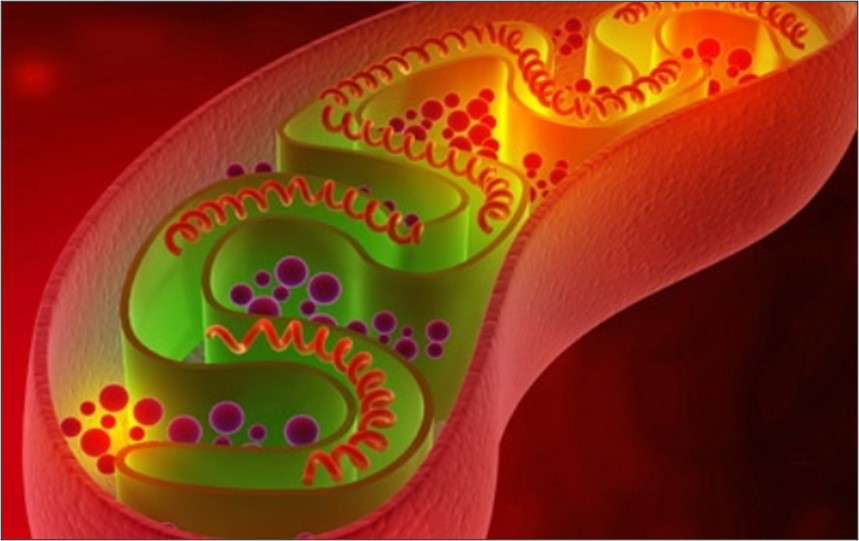The role of mitochondrial DNA (mtDNA) has been studied intensely apart from its role in energy production. It has a myriad of functions in the cell and its origin and evolution are essential parts of the evolution of life. Also, mtDNA is considered as one of the most valuable tools in population genetics and molecular phylogenetics. Mitochondrial inheritance simply means the inheritance of a trait encoded in the mitochondrial genome. This type of inheritance does not obey the classic rules of genetics. Persons with mitochondrial disease may be male or female but they are always related in the maternal line and no male with the disease can transmit it to his children. Mitochondria, like chloroplasts, tend to be inherited from just one parent or the other. This pattern of inheritance is known as uniparental inheritance. A MtDNA copy can be inherited entirely unchanged through the maternal line. This mode of inheritance is called the maternal inheritance of mitochondrial DNA.
Mitochondrion: Much More than an Energy Converter
A mitochondrion, also known as the ‘powerhouse of the cell,’ is an important cell organelle responsible for producing ATP (adenosine triphosphate), which is essential for proper cellular functioning. Besides energy production, scientists have observed much more significance of mitochondria. Mitochondria help in calcium storage, metabolism regulation, cell death control, cell signaling, and various other functions. Similar to chloroplasts in plants and algae, but unlike other intracellular organelles, mitochondria contain their own genetic materials. The mitochondrial genes and genomes are inherited differently and independently from that of nuclear genes and genomes. In most animals, the mtDNA is a short, circular molecule that contains about 13 intronless, protein-coding genes. These 13 genes synthesize enzymes that are involved in oxidative phosphorylation (OXPHOS). OXPHOS is a process in which the cells’ main energy source, ATP, is produced. The prevailing view is that animal mtDNA is maternally transmitted, non-recombining and has an elevated mutation rate compared to nuclear DNA.
Mitochondrial DNA at a Glance
i. Human mitochondrial DNA is a double-stranded, circular molecule, having its own genome of about 16,569 bp. Each contains 13 protein-coding genes, 2 rRNAs, 22 tRNAs.
ii. They have a higher rate of mutation than nuclear DNA.
iii. They do not recombine.
iv. What is peculiar to MtDNA is the fact that this DNA is maternally inherited. Offspring inherits a copy of MtDNA from their mother. On the other hand, nuclear DNA is inherited equally from both parents.
Maternal Inheritance of Mitochondrial DNA in Humans
It is well-documented that in nearly all known animals, mitochondrial DNA is inherited exclusively from the mother. This acquisition is fixed and that is why researchers often analyse mitochondrial DNA to trace maternal lineages back in time. In humans, usually, mitochondria tend to be inherited from a person’s mother. This is known as maternal inheritance. The mother contributes mitochondria to the zygote, or one-celled embryo, through the egg’s cytoplasm. Sperms do contain mitochondria, but the zygote does not usually inherit them. Although there has been a reported case of paternal inheritance of mitochondria in a human, this is extremely rare. Few theories have come to the forefront of why we do not inherit DNA from fathers during mitochondrial inheritance. Firstly, the mitochondria of sperm are thought to undergo higher rates of mutation than those in eggs. This may result in risks in their offspring. Also, having only one type of mitochondria makes it easier for the genomes in the nucleus and mitochondria to coordinate.
Mitochondrial mutations lead to the development of mitochondrial genetic disorders and these are transmitted by maternal inheritance. In case of any abnormalities in the mother’s mitochondria, it will be passed on to her offspring, but the defect will not be inherited by his offspring if the father has any abnormalities in the mitochondria. Due to this type of inheritance, males with mitochondrial disease are not considered as a risk for their offspring.
Conclusion
Though small in size, the mitochondrial genome is responsible for ensuring that the powerhouses of our cells function properly. This circular genome is more prone to mutation. Currently, it is difficult to predict the way in which mtDNA mutations will pass from mother to child due to the interplay between the mitochondrial and nuclear genomes. However, it is clear that these mutations are more pronounced in tissues that place high energy demands on mitochondria. Despite this, mtDNA mutations are not entirely a bad thing. In fact, the variability introduced into mtDNA sequences by these mutations helps link family members to one another and has proven useful in reuniting missing children with their mothers, grandmothers, brothers, and sisters. Continued study of this fascinating genome will continue to expand our understanding of human disease and human history for years to come.

